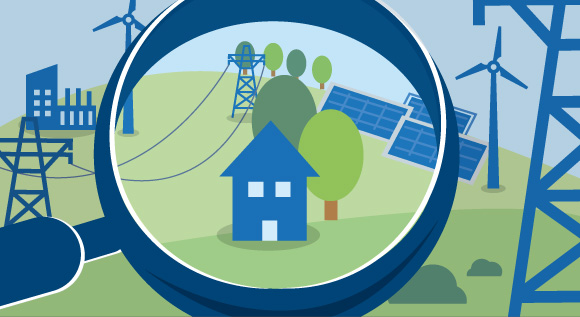What is a ‘passive house’?
There is one thing that passive houses do extremely well: save energy! How do these buildings, which are particularly energy-efficient, work? And what kind of funding is available for those wanting to build a passive house?
 © BMWi
© BMWiIt’s about houses that use very little heat
Can you imagine living in a house without any central heating, electrical heaters or an open fireplace? Even in winter? Well, it can be done – and not only in the mild South of Europe, but also in Germany’s climate. Passive houses are extremely well insulated and transfer very little heat to their surroundings. Their outside walls, their roof and floors come with very effective thermal insulation, thus minimising the amount of heat that is lost. In order to compensate for the amount of heat that does get out, the passive house uses passive sources of energy – energy that already exists in the house. This includes residual heat from electrical devices, the residents’ body heat and solar energy that is captured via large windows. Consequently, passive houses only need a small conventional heating system or none at all.
They use up to 90 per cent less heat than old buildings that have not been modernised, and 30 to 45 per cent less than an average new building that has been built according to obligatory minimum standards. Passive houses therefore make an important contribution to the energy transition. In Germany, buildings still account for around 35 of total energy consumption. If Germany is to meet its climate targets, the country’s existing and new buildings therefore need to become more efficient. But passive houses not only benefit the climate, but also the people living in the house as they see their energy bills drastically reduced. In Germany, a passive house is defined as a house that uses no more than 15 kilowatt-hours of heat per square meter per year.
A passive house is not a protected trademark, but a concept that can be used by anyone
The first passive houses were built 25 years ago, with the prototype standing in Darmstadt. The passive house is not a protected trademark, but a building concept that can be used by anyone. However, the independent Passive House Institute (PHI) provides a certificate that attests to the quality of the passive house, providing builders with a confirmation that their building is in line with passive house standards. According to information provided by the PHI, there are more than 55,000 passive house units across Europe and 10,000 more in other parts of the world (a Chinese project that has been certified by the PHI is also described in this article).
Modern ventilation systems help keep heat inside the building
The building envelope of a passive house is quite thick, so very little heat is lost. However, exhaust air and humidity from the bathroom or the kitchen still need to be removed from the house in a controlled manner. One option is to open the windows and let fresh air in. However, this is not a very comfortable option and does not ensure an optimised exchange of air throughout the day. And opening the windows loses a lot of valuable heat. So another option is using a ventilation system that ensures that fresh air can get in from the outside in a controlled manner. This system also recovers heat from exhaust air, thus minimising the loss of heat. It does so by absorbing thermal energy from the exhaust air and feeding it back into the flow of fresh air that comes in from the outside. The system can used 80 to 95 per cent of the energy that has been recovered. This helps keep temperatures inside the house at a constant and comfortable level. On particularly cold days, heat recovery may not be sufficient to heat up the incoming air. In this case, the ventilation system can be used to heat it up to a comfortable temperature.
KfW provides funding for new passive houses
In Germany, KfW uses funding from the CO2 building renovation programme run by the Federal Ministry for Economic Affairs and Energy to fund the building of energy-efficient residential buildings. KfW’s funding scheme dedicated to this purpose is entitled ‘Energy-efficient Construction’. The scheme works as follows: The more energy-efficient a building is, the more funding it will receive. This funding takes the form of low-interest loans and investment grants.
The passive house standard is not confined to residential buildings; office buildings and municipal buildings such as schools can also be constructed according to this standard. KfW – on behalf of the Federal Ministry for Economic Affairs and Energy – has developed funding schemes dedicated for these purposes too.

